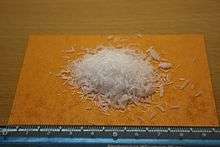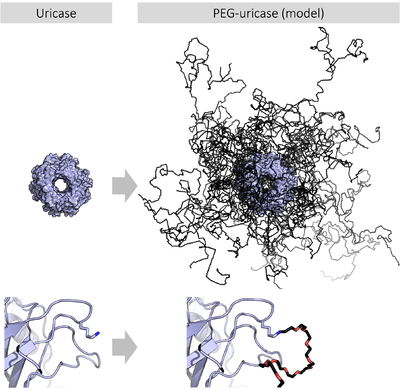Macrogol
_alternate.svg.png) | |
| Clinical data | |
|---|---|
| AHFS/Drugs.com | International Drug Names |
| MedlinePlus | a603032 |
| Routes of administration | Oral, topical |
| ATC code | A06AD15 (WHO) |
| Legal status | |
| Legal status | |
| Pharmacokinetic data | |
| Bioavailability | None |
| Excretion | Faeces (100%) |
| Identifiers | |
| |
| Synonyms | Polyethylene glycol (PEG) |
| CAS Number |
25322-68-3 |
| ChemSpider | none |
| UNII |
3WJQ0SDW1A |
| ChEMBL |
CHEMBL1201478 |
| Chemical and physical data | |
| Formula | H–(OCH2CH2)n–OH |
| Molar mass | Varies |
| | |
Macrogol is the international nonproprietary name for polyethylene glycol (PEG). Macrogols are commonly used as laxatives, i.e. to treat constipation, in both children[1] and adults.[2]
Lower molecular weight macrogols are used as excipients in pharmaceutical products as solvents in oral liquids and soft capsules. Solid variants are used as ointment bases, tablet bindings, film coatings and lubricants.[3]
Macrogols are also attached to biopharmaceutical drugs to slow down their degradation in the human body and increase their duration of action, as well as to reduce immunogenicity. This process is called PEGylation.[4]
Popular types include:
The number represents the average molecular mass. Combining different molecular masses provides some control over the consistency.[3]
Medical uses
Laxative

Macrogol 3350, often in combination with electrolytes, is used for short-term relief of constipation as well as for long-term use in constipation of various causes, including in multiple sclerosis and Parkinson's disease patients (an often-overlooked non-motor symptom) as well as constipation caused by pharmaceutical drugs such as opioids and anticholinergics. Whole bowel irrigation with macrogol is part of the bowel preparation before surgery or colonoscopy. Limited data also support its use for the treatment of fecal impaction.[7]
A 2007 comparison showed that patients suffering from constipation had a better response to macrogol than to tegaserod.[8]
Excipient
Macrogol is used as an excipient in many pharmaceutical products. Lower-molecular-weight variants are used as solvents in oral liquids and soft capsules, whereas solid variants are used as ointment bases, tablet binders, film coatings, and lubricants.[3] It is also used in lubricating eye drops.
PEGylation

When attached to various biopharmaceutical medications (which are proteins), macrogol results in a slowed clearance of the carried protein from the blood. This makes for a longer-acting medicinal effect and reduces toxicity, and it allows for longer dosing intervals. It also reduces the proteins' immunogenicity. Examples for PEGylated proteins include peginterferon alfa-2a and -2b, which are used to treat hepatitis C, pegfilgrastim, which is used to treat neutropenia, and pegloticase for the treatment of gout.[7]
Other
Macrogol is also commonly used to fuse B-cells with myeloma cells in monoclonal antibody production.[10]
Contraindications
Contraindications for macrogol taken orally as a laxative are intestinal perforation, bowel obstruction, ileus, inflammatory bowel diseases, and toxic megacolon.[7]
The doses of macrogol as an excipient are too low to have relevant contraindications.
Allergy to macrogol is rare, and usually appears as an allergy to an increasing number of seemingly unrelated products, including cosmetics, drugs that use it as an excipient, and peri-procedural substances such as ultrasound gel.[11]
Adverse effects
Oral macrogol is generally well tolerated. Possible side effects include headache, bloating, nausea, allergies, and electrolyte imbalance, mainly hypokalaemia (low blood potassium levels) and hyperkalaemia (high blood potassium levels). Hyperkalaemia is not an effect of macrogol itself but of potassium salts which are usually part of macrogol formulations.[7] With excessive use, it can cause diarrhea.
Interactions
The interaction potential is low. Resorption of other pharmaceutical drugs can be reduced because oral macrogol accelerates intestinal passage, but this is seldom clinically relevant. For antiepileptic drugs, such a mechanism has been described in rare cases.[7]
Pharmacology
Mechanism of action as a laxative
Macrogol is an osmotically acting laxative, that is an inert substance that passes through the gut without being absorbed into the body. It relieves constipation because it causes water to be retained in the bowel instead of being absorbed into the body. This increases the water content and volume of the stools in the bowel, making them softer and easier to pass, as well as improving gut motility.[7][12][13]
Chemistry
Available forms
Macrogol is sold as non-prescription preparation in powder form. When sold as a laxative, it is pure. When sold for gut cleansing, it is usually in combination with salts such as sodium bicarbonate, sodium chloride and potassium chloride to help mitigate the possibility of electrolyte imbalance and dehydration. Trade names include SoftLax, Purelax, Miralax, Glycoprep, Movicol, Cololyt and Osmolax, and many others. It is dissolved in water to create a clear and odorless solution and is swallowed. While most consumers find the taste of macrogol itself to be very mild and unobjectionable, the electrolytes contained in formulations for purging and cleansing give the solution an extremely salty and bitter taste.
Research
- It has been shown that macrogol can improve healing of spinal injuries in dogs.[14]
- One of the earlier findings is that macrogol can aid in nerve repair.[15]
- Macrogol, when labeled with a near-infrared fluorophore, has been used in preclinical work as a vascular agent, lymphatic agent, and general tumor-imaging agent by exploiting the enhanced permeability and retention effect (EPR) of tumors.[16]
- High-molecular-weight macrogol (e.g., 8000 g/mol) has been shown to be a dietary preventive agent against colorectal cancer in animal models.[17]
- The Chemoprevention Database shows macrogol is the most effective known agent for the suppression of chemical carcinogenesis in rats. Cancer prevention applications in humans, however, have not yet been tested in clinical trials.[18]
- The subcutaneous injection of macrogol 2000 in guinea pigs after spinal cord injury leads to rapid recovery through molecular repair of nerve membranes.[19] The effectiveness of this treatment to prevent paraplegia in humans after an accident is not known yet.
- Macrogol is being used in the repair of motor neurons damaged in crush or laceration incidents in vivo and in vitro. When coupled with melatonin, 75% of damaged sciatic nerves were rendered viable.[20]
References
- ↑ Gordon M, Naidoo K, Akobeng AK, Thomas AG (2012). "Osmotic and stimulant laxatives for the management of childhood constipation". Cochrane Database of Systematic Reviews (7). doi:10.1002/14651858.CD009118.pub2.
- ↑ Zangaglia R, Martignoni E, Glorioso M, et al. (2007). "Macrogol for the treatment of constipation in Parkinson's disease. A randomized placebo-controlled study". Mov. Disord. 22 (9): 1239–44. doi:10.1002/mds.21243. PMID 17566120.
- 1 2 3 Smolinske, Susan C. (1992). Handbook of Food, Drug, and Cosmetic Excipients. p. 287. ISBN 9780849335853.
- ↑ Veronese, FM; Harris, JM (2002). "Introduction and overview of peptide and protein pegylation". Advanced drug delivery reviews. 54 (4): 453–6. doi:10.1016/S0169-409X(02)00020-0. PMID 12052707.
- ↑ Hardikar W, Cranswick N, Heine RG (2007). "Macrogol 3350 plus electrolytes for chronic constipation in children: a single-centre, open-label study". Journal of Paediatrics and Child Health. 43 (7–8): 527–31. doi:10.1111/j.1440-1754.2007.01116.x. PMID 17635680.
- ↑ Hyry H, Vuorio A, Varjonen E, Skyttä J, Mäkinen-Kiljunen S (2006). "Two cases of anaphylaxis to macrogol 6000 after ingestion of drug tablets". Allergy. 61 (8): 1021. doi:10.1111/j.1398-9995.2006.01083.x. PMID 16867059.
- 1 2 3 4 5 6 Haberfeld, ed. (2015). Austria-Codex (in German). Vienna: Österreichischer Apothekerverlag.
- ↑ Di Palma, Jack A.; Cleveland, Mark vB.; McGowan, John; Herrera, Jorge L. (2007). "A Randomized, Multicenter Comparison of Polyethylene Glycol Laxative and Tegaserod in Treatment of Patients With Chronic Constipation". The American Journal of Gastroenterology. 102 (9): 1964–71. doi:10.1111/j.1572-0241.2007.01365.x. PMID 17573794.
- ↑ Sherman, MR; Saifer, MG; Perez-Ruiz, F (3 January 2008). "PEG-uricase in the management of treatment-resistant gout and hyperuricemia.". Advanced drug delivery reviews. 60 (1): 59–68. doi:10.1016/j.addr.2007.06.011. PMID 17826865.
- ↑ Lo, M. M.; Tsong, T. Y.; Conrad, M. K.; Strittmatter, S. M.; Hester, L. D.; Snyder, S. H. (1984). "Monoclonal antibody production by receptor-mediated electrically induced cell fusion". Nature. 310 (5980): 792–4. Bibcode:1984Natur.310..792L. doi:10.1038/310792a0. PMID 6088990.
- ↑ Wenande, E.; Garvey, L. H. (2016-07-01). "Immediate-type hypersensitivity to polyethylene glycols: a review". Clinical and Experimental Allergy: Journal of the British Society for Allergy and Clinical Immunology. 46 (7): 907–922. doi:10.1111/cea.12760. ISSN 1365-2222. PMID 27196817.
- ↑ Mutschler, Ernst (2013). Arzneimittelwirkungen (in German) (10 ed.). Stuttgart: Wissenschaftliche Verlagsgesellschaft. p. 608. ISBN 978-3-8047-2898-1.
- ↑ Chaussade, S (1999). "Mechanisms of action of low doses of polyethylene glycol in the treatment of functional constipation". Italian journal of gastroenterology and hepatology. 31 Suppl 3: S242–4. PMID 10726227.
- ↑ Bowman, Lee (4 December 2004). "Study on dogs yields hope in human paralysis treatment". seattlepi.com.
- ↑ Krause, T. L.; Bittner, G. D. (1990). "Rapid morphological fusion of severed myelinated axons by polyethylene glycol". PNAS. 87 (4): 1471–1475. Bibcode:1990PNAS...87.1471K. doi:10.1073/pnas.87.4.1471. PMC 53497
 . PMID 2304913.
. PMID 2304913. - ↑ Kovar, J., Wang, Y., Simpson, M.A., and Olive, D.M., "Imaging Lymphatics With A Variety of Near-Infrared-Labeled Optical Agents", World Molecular Imaging, (2009)
- ↑ Corpet, D. E.; Parnaud, G; Delverdier, M; Peiffer, G; Taché, S (2000). "Consistent and Fast Inhibition of Colon Carcinogenesis by Polyethylene Glycol in Mice and Rats Given Various Carcinogens". Cancer Research. 60 (12): 3160–3164. PMID 10866305.
- ↑ Chemoprevention Database. Inra.fr. Retrieved on 30 November 2012.
- ↑ Borgens, R. B.; Bohnert, D (2001). "Rapid recovery from spinal cord injury after subcutaneously administered polyethylene glycol". Journal of Neuroscience Research. 66 (6): 1179–1186. doi:10.1002/jnr.1254. PMID 11746451.
- ↑ Stavisky, R. C.; Britt, J. M.; Zuzek, A; Truong, E; Bittner, G. D. (2005). "Melatonin enhances the in vitro and in vivo repair of severed rat sciatic axons". Neouroscience Letters. 376 (2): 98–101. doi:10.1016/j.neulet.2004.11.033. PMID 15698928.